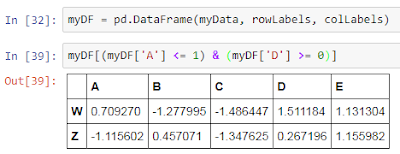Hi friends,
Welcome to yet another post on Pandas DataFrames. In the previous post under Data Science & Machine Learning, we discussed how to create a DataFrame using the Pandas library and perform basic operations on DataFrames. In this post, we discuss a more detailed usage of Pandas DataFrames for performing Data Analysis tasks.
Note: All the commands discussed below are run in the Jupyter Notebook environment. See this post on Jupyter Notebook to know about it in detail.
We use the same steps we used in the previous post to create a sample Pandas DataFrame:
So, let's starting working with some examples. So, if we wanted only the non-negative (>=0) elements of our DataFrame, we use Conditional Selection in the following manner:
We can apply Conditional Selection to individual columns as well. Here is the step to achieve the same:
Notice that the entire row corresponding to 'Y' index has been dropped from the result since the value corresponding to its column 'D' was negative.
Since the result of the above conditional selection is also a DataFrame, we can also select only a subset of columns from the resultant DataFrame. Here is an example selecting only the columns 'A' and 'E' of the resultant DataFrame:
What it is basically doing is first dropping the rows corresponding to which the value of the element is negative in the 'D' column and then selecting the columns 'A' and 'E' from the resultant DataFrame. It might appear intimidating if you are a beginner but you can grasp it better with practice.
We can also supply multiple conditions at the same time as well using the conditional operator & and |:
We can also change the index i.e. the row labels of the DataFrame using the set_index() method. However, there is a constraint with the set_index() method that the new row labels to be set should be one of the existing columns only. So, we first add a column to our DataFrame and use that temporary column to change the index using set_index() method:
Notice that first I have add a temporary column to our DataFrame which is later used to set the new index of our DataFrame.
With this, we end this post here on Conditional Selection on Pandas DataFrames. In the next post, we will learn Data Science techniques on how do we deal with missing values in a Pandas DataFrame.
We use the same steps we used in the previous post to create a sample Pandas DataFrame:
Conditional Selection on Pandas DataFrames
Just like we performed Conditional Selection on NumPy Arrays, we will learn to do the same with Pandas DataFrames in this post. Conditional Selection as described earlier allows us to access the elements of a particular data structure (here DataFrames) based on conditions i.e. select only those elements of the data structure for which the condition(s) is met.So, let's starting working with some examples. So, if we wanted only the non-negative (>=0) elements of our DataFrame, we use Conditional Selection in the following manner:
- Get the boolean array corresponding to each cell in the DataFrame based on its value
- Use the extracted boolean values to filter out the negative values
We can apply Conditional Selection to individual columns as well. Here is the step to achieve the same:
Notice that the entire row corresponding to 'Y' index has been dropped from the result since the value corresponding to its column 'D' was negative.
Since the result of the above conditional selection is also a DataFrame, we can also select only a subset of columns from the resultant DataFrame. Here is an example selecting only the columns 'A' and 'E' of the resultant DataFrame:
What it is basically doing is first dropping the rows corresponding to which the value of the element is negative in the 'D' column and then selecting the columns 'A' and 'E' from the resultant DataFrame. It might appear intimidating if you are a beginner but you can grasp it better with practice.
We can also supply multiple conditions at the same time as well using the conditional operator & and |:
We can also change the index i.e. the row labels of the DataFrame using the set_index() method. However, there is a constraint with the set_index() method that the new row labels to be set should be one of the existing columns only. So, we first add a column to our DataFrame and use that temporary column to change the index using set_index() method:
Notice that first I have add a temporary column to our DataFrame which is later used to set the new index of our DataFrame.
With this, we end this post here on Conditional Selection on Pandas DataFrames. In the next post, we will learn Data Science techniques on how do we deal with missing values in a Pandas DataFrame.











0 comments:
Post a Comment